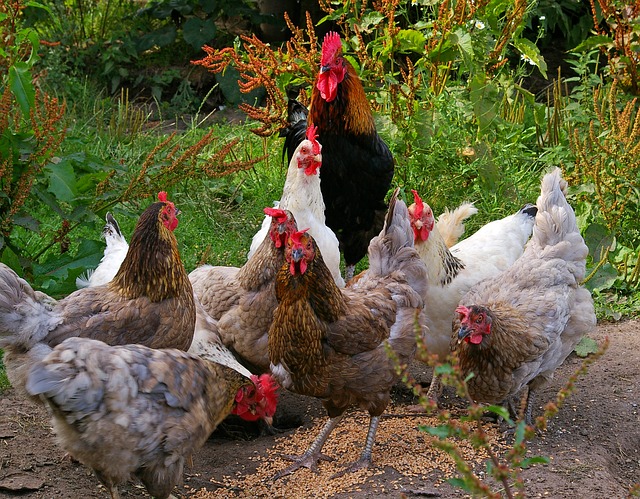
How To Be More Self-Reliant Right Where You Are!
If you are wondering how to be more self-reliant you are in good company! Many people are interested in increasing their self-reliance, saving money, and living a more sustainable lifestyle. The good news is that you can achieve this no matter where you live.
When we think of being self-reliant, the image of a large garden, apple trees, cattle, or fields of grain comes to mind. But there are many things you can do to increase your self-sufficiency without moving to a large farm in the country!
This post contains affiliate links or advertisements. You won’t pay extra but I may earn a small commission if you purchase products through those links. Thank you for supporting The Self Sufficient HomeAcre!


Self-Reliant Skill Sets
People who grew up learning self-reliance skills from their family do have an advantage on a homestead. However, you can do more for yourself and learn new skills no matter what your age or background.
If you are new to self-reliance and homesteading, remember to take on one or two projects at a time and build your skill sets over time. Don’t rush into a dozen projects all at once and burn out!
Here are some important skills that will make you more self-reliant:
- Horticulture – Grow plants for food, medicine, fuel, building supplies, and for sale. Learn to identify and forage wild plants to supplement your garden and orchard.
- Carpentry & Woodworking – Build structures, remodel existing buildings, and create furniture, tools, fences, utensils, and other items for the homestead.
- Cooking from Scratch – Cook and bake from basic ingredients instead of purchasing prepared goods. Turn the food you grow into healthy meals.
- Food Preservation – Can, dehydrate, ferment, cure, and freeze your homegrown foods to save for winter.
- Fiber and Fabric Arts – Sew, knit, crochet, spin or felt wool, weave, and quilt, embroider or cross-stitch to create clothing, home goods, and gifts.
- Animal Husbandry – Raise and care for poultry, rabbits, goats, alpacas, sheep, pigs, cattle, horses, pets, and guardian animals.
- Natural Health – Leading a healthy lifestyle and learning basic healthcare skills may reduce trips to the doctor. (But please see your doctor if you are sick!)
- Making Your Own Cleaning & Personal Care Products – Ditch the store-bought products in plastic and learn to make your own non-toxic products.
- Trade Skills – Plumbing, electrical, mechanical, and engine repair skills will save you a great deal of money on the homestead.
What Resources Do You Need to Increase Your Self-Reliance?
You don’t need a large plot of land in the country, an orchard, a tractor, or livestock to be more self-sufficient. Apartment dwellers in the city can do many things for themselves! However, Suburbanites have even more options, and those with rural land have the most potential to provide for themselves.
Some products make homesteading and self-reliance projects easier and faster, but they are not all necessary. Consider purchasing a hot water bath canner, pressure canner, food dehydrator, and mason jars for food preservation.
Some basic tools are needed for preparing and tending a garden, such as a spade, trowel, and perhaps a bucket and some gloves. You’ll need seeds and plants, too.
An off-grid homestead will require hand tools instead of electric-powered tools unless you are using a generator.

Acquire Resources Over Time
Many of these things are not necessary and you certainly shouldn’t go out and buy everything all at once. Wait and see what you need to accomplish the tasks at hand.
Try some of the self-reliance projects you can take on with the resources you have available. As you build on your skills, purchase or barter for the items you need to be more productive.

Urban Self Reliance
You might wonder how self-reliant you can be in an apartment or small urban home. Looking at the list of skills above, there are many things you can learn to do for yourself. Some of the suburban self-reliance projects might also work for you. Be sure to check building codes, zoning laws, and health department regulations when necessary.
Try some of these ideas to be more self-reliant, save money, and provide for yourself:
- Walk or bike when possible
- Look for a community garden plot nearby
- Turn a small yard into a permaculture oasis
- Start a container garden on a rooftop or balcony
- Buy reusable water bottles and a water filter instead of bottled water
- Keep bees on a rooftop or in an approved park
- Pack your lunch instead of buying it
- Volunteer at a botanical garden for free gardening experience
- Forage for wild edibles
- Reuse and repair items instead of replacing them
- Plant vegetables in a parkway or abandoned lot
- Learn to bake bread and make a sourdough starter
- Use vinegar and baking soda for cleaning
- Reduce meat consumption
- Purchase dried beans instead of canned beans
- Grow microgreens and sprouts in a sunny window
- Grow herbs and greens under lights indoors
- Shop at farmers’ markets or join a CSA for fresher produce
- Chop up vegetable scraps and use them to make broth
- Keep 2 or 3 chickens if possible
- Make wine or beer at home
- Save bones to make bone broth
- Preserve food with a canner, dehydrator, or freezer
- Ferment, pickle, or cure extra food
- Sew, knit, crochet, or weave your own clothing and accessories
- Learn plumbing, electrical, and home repair skills
- Join a buying club to purchase at a discount
- Learn woodworking and carpentry skills
- Make yogurt, sour cream, buttermilk, fresh cheese, and other dairy products
- Eat more meals at home
- Share babysitting and pet-sitting responsibilities with friends you trust
- Start a worm composting system for your kitchen scraps
- Go to the library or read free ebooks
- Stream free movies and videos instead of paying for cable
- Try hobbies such as drawing or whittling for entertainment
- Try a ‘staycation’ instead of an expensive vacation
- Give up bad habits to save money and stay healthy
- Hunt and fish on public lands (follow local laws)
- Make your own non-toxic bath and body products
- Put together mason jar mixes for hot cocoa, muffins, and cookies
- Use a vacuum sealer to divide up bulk goods and keep them longer
- Invite friends for a potluck and play a board game instead of going out
- Make your own vapor rub and honey cough syrup for cold symptoms
- Bake a cake, cookies, or muffins to give as gifts instead of purchasing
- Learn to sew a tote bag from canvas or a recycled birdseed bag
- Buy dishes from a thrift store instead of using paper plates and cups
- Make organic pest control instead of using toxic sprays
- Hang insulating curtains in your windows to save energy

Suburban Self Reliance
Many of the self-reliance skills and projects for urbanites may also work well on a suburban plot. However, you can do quite a bit more in the ‘burbs. You’ll probably have more space to store materials, tools, and finished projects. Don’t forget to check building codes, zoning laws, and health department regulations before taking on some projects.
Try these additional ideas to increase your self-reliance:
- See projects for urban self-reliance, above
- Build a raised bed garden
- Plant dwarf fruit trees
- Build a coop and keep laying hens if approved
- Plant perennial fruits (strawberries, blueberries, grapes, etc.)
- Install awnings, trellis, or an arbor to keep the home cooler in summer
- Keep one or two Nigerian dwarf goats for milk
- Learn to make soap
- Raise rabbits for fiber, fertilizer, and meat
- Plant perennial herbs and vegetables
- Start your own vegetable transplants indoors
- Build a small greenhouse for extending your growing season
- Install solar panels on your roof to provide energy for your home
- Use public transportation to reduce your fuel needs
- Carpool or work from home, if possible
- Plant trees for shade and windbreaks
- Add extra insulation in your attic to reduce energy costs
- Purchase a fuel-efficient or electric vehicle
- Compost yard waste and kitchen scraps
- Start a community group for potlucks or kids’ playgroups
- Go to the library, park, or a community center for entertainment
- Remodel or organize your home instead of moving to a larger home
- Start a small aquaculture system in your backyard
- Grow heirlooms and save seeds in a seed bank

Rural Self Reliance
Having a nice-sized parcel of land opens up a whole new world of possibilities to be more self-reliant. There are trade-offs, such as commuting to a job, distance to shopping, and fewer opportunities for entertainment. Think carefully about relocating if these issues will increase your cost of living.
Of course, you can take part in any of the projects listed above for urban and suburban dwellers. Here are other options to increase your self-reliance and even subsidize your income:
- Raise wheat, oats, corn, & field peas to feed your family and livestock
- Make maple syrup for home use and for sale
- Grow a large garden to provide enough food for your family, to preserve for winter, and sell extras at a farmer’s market
- Hunt, fish, and forage for wild foods on your own land
- Store root crops for winter vegetables
- Use a pond to raise fish for harvesting
- Raise livestock for meat, milk, eggs, and fiber
- Plant an orchard and preserve extra fruit for winter
- Raise cutting flowers for your home or to sell
- Make cheese and other cultured dairy products from extra milk
- Start your own beekeeping business and sell honey, comb honey, and beeswax
- Make your own candles from beeswax
- Replace sugar with honey or maple syrup in recipes
- Harvest and split firewood to heat your home and sell small bundles or cords if you have extra
- Start a Christmas tree farm
- Raise holly, curly willow, Henry Lauder’s walking stick, pussy willow, or other decorative plant materials for sale to the craft supply industry
- Grow black oil sunflower seed to feed poultry, pigs, goats, and wild birds
- Raise pastured poultry, pork, goat, lamb, and beef to sell
- Plant several rows of evergreen trees on the north and west sides of your property as a windbreak
- Build and sell garden sheds, Adirondack chairs, chicken coops, picnic tables or other woodworking projects
- Learn basic veterinary skills to treat sick or injured animals when possible
- Raise purebred livestock to show and sell
- Butcher old laying hens to make soup and chicken stock
- Start a boarding kennel for dogs or horses
- Keep broody hens or incubate eggs instead of ordering chicks
- Offer a farm-sitting service
- Propagate perennials from cuttings or division to sell
- Sell eggs, pickles, preserves, and other value-added goods
- Butcher extra roosters and can the meat
- If you have a livestock trailer, offer a livestock hauling service
- Mend clothes instead of buying new ones
- Start a pumpkin patch, corn maze, or apple orchard for a seasonal business
- Reduce the size of your lawn to save on gas for the lawnmower
- Sell excess hay and straw
- Feed kitchen scraps to chickens and pigs
- Don’t raise more than you can use or sell, to save money and energy

Grow and Save Your Way to Self-Reliance
We often think of self-reliance as increasing our production of food and other resources. That’s important, but there is another side of self-reliance…reducing the resources that we need.
Start with all of your purchases and homegrown resources and take a hard look at how much is wasted. Do you throw away groceries every week because you bought more than you need? Are freezer burned veggies and meat tossed out because you raised or bought too much? Take some time to rethink purchases and production.


Before you order 200 chicks, plow up an acre for the garden, or buy a gross of canning jars, stop and think carefully about how likely you are to use all of those eggs, veggies, and canning jars.
Start with a dozen chickens and learn from that experience. Put in a small garden. Wash and reuse jars from store-bought goods to store dried fruits and herbs. Find out what projects are worthwhile before investing your time and money in a large venture.
Find ways to reduce your expenses on entertainment and extras. You may find that sitting on the porch watching chickens scratch in the grass is more entertaining than television!

Free or Cheap Ways to Increase Self Reliance are Best!
- Work smarter not harder.
- Use the resources you have already on hand.
- Reduce waste and cut back on spending.
- Wait a week before you make a large purchase unless it’s an emergency.
- Shop at garage sales and thrift shops.
- Grow heirlooms and save seeds.
- Know how to tell a good quality tool from a cheap one.
- Learn from your neighbors, family, and friends, or watch Youtube videos before you start a project.
- Get free resources from the library.
- Find your local Extension Office. They have good information about food preservation and preparation, gardening, and farming.
- Once you learn a new skill, practice it…then learn another skill!
- Learn to be happy with less. Sometimes, when we slow down and learn to appreciate the little things, we realize that maybe these are actually the big things in life.
How do you increase your self-reliance? Leave a comment!


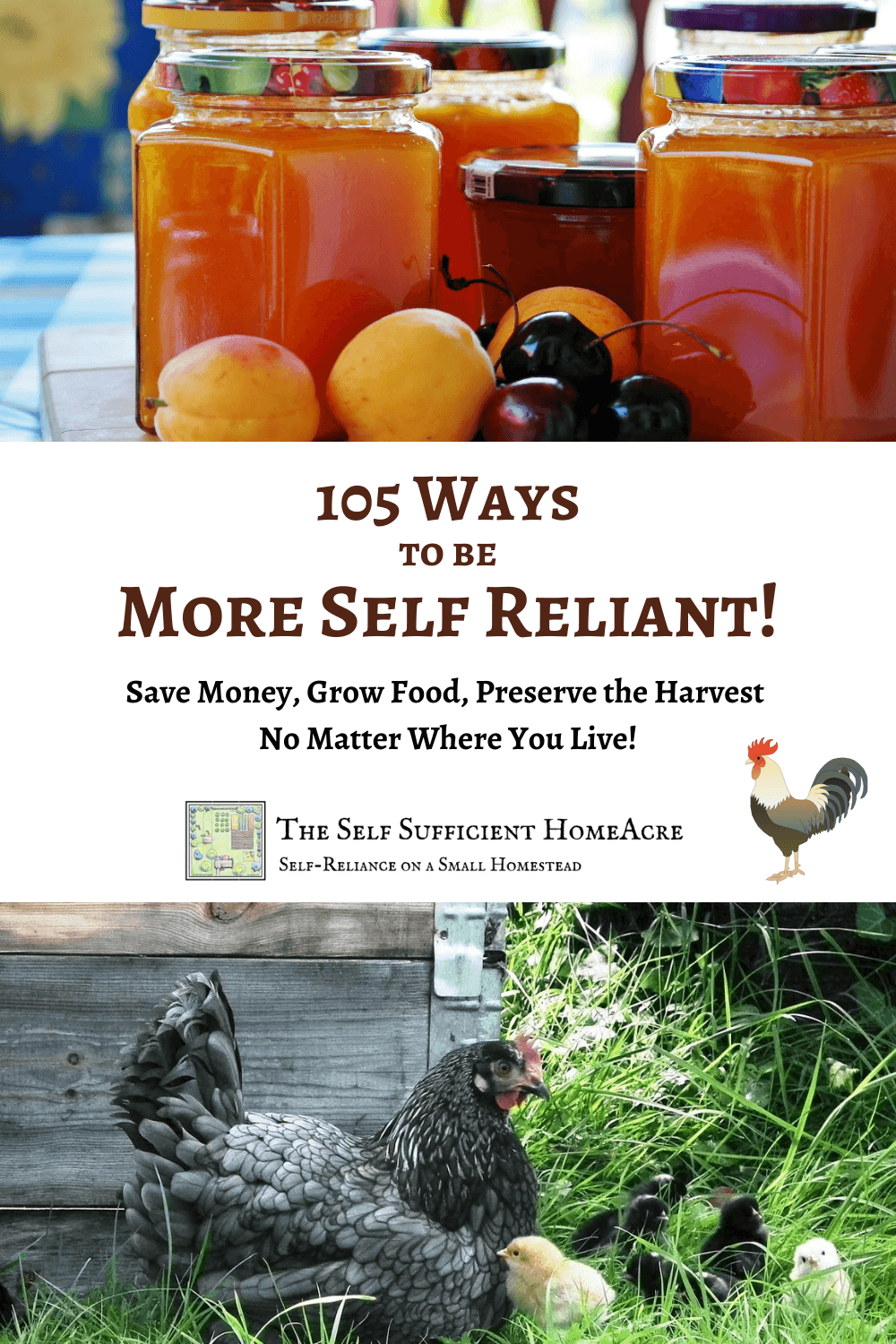



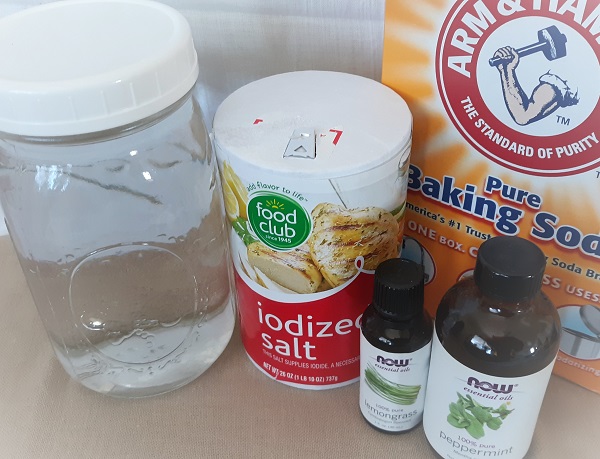
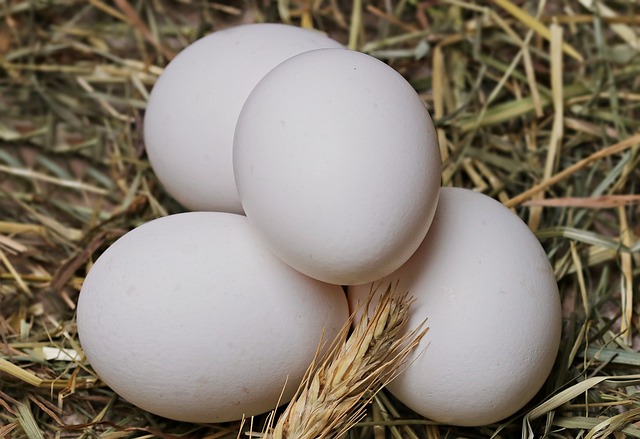
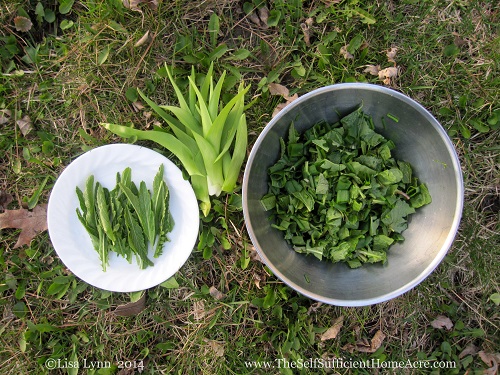

Thank you for this great list, just what I was looking for!
Cheers!
You’re welcome, Heidi!
Thank you so much for this list, it is very helpful!
Happy to share!
We are far from self reliant, especially this year when I could be home in time to plant a garden. We do live most of the year off the grid in a float cabin. That has helped us learn lots of ways to live in a more simple manner. – Margy
Lisa, After reading your list of 105 ways, We’re farther along than I thought. We’ve managed 100 ways on our homestead. We’re small with only 2 acres so selling hay and the like isn’t possible.
I’d add …
The ability to thinking outside the box to your list.
Rather than buying new buy used (it’s already broken in)
Instead of buying, reuse,repurpose, upcycle.
Frugality is key. Homesteading is not cheap in the beginning.
Nancy is right about being flexible.
That’s great, Jo! Thank you for the additions! Yes, mindset is very important.
I’d add a few things as well like being flexible in your plans. Sometimes things unexpectedly happen and you have to be able to deal with them. I’d also say you have to have a judgment call when it’s time to hire a professional to do job. So I think there’s some mental skills and personality traits that are really helpful to being self-reliant
Very true! Thanks for your input, Nancy!